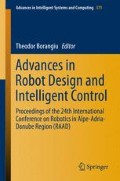Abstract
The work presented in this paper reports a research done in order to optimize the relation speed—trajectory length for a complex robotic assembly task. The assembly task consists in fixing an engine part with 8 screws, the screws being already inserted and pre-fixed but not tightened; in some cases the screws must be screwed for a length of 1 cm, and then tightened at 25 Nm. The operation duration (cycle time) should be of maximum 45 s measured from the time the pallet enters in the working area until the pallet exits the working area. Due to the conveyor operation which takes 12 s to place the pallet in the working position and to remove the pallet from the working area, only 33 s remain for the robot operation including the operation time of the screwdriver placed on the robot. The solution is based on developing an algorithm that uses the dynamics equations of the robot to compute the time needed to accomplish the task, based on the load of the robot and the stop points on the trajectory.
Access this chapter
Tax calculation will be finalised at checkout
Purchases are for personal use only
References
Carlson, J.S., Spensieri, D., Wärmefjord, K., Segeborn, J., R. Söderberg: Minimizing dimensional variation and robot traveling time in welding stations, Procedia CIRP. 23, 77–82 (2014)
Huang, Y., Chiba, R., Arai, T., Ueyama, T., Ota, J.: Robust multi-robot coordination in pick-and-place tasks based on part-dispatching rules. Robot. Auton. Syst. 64, 70–83 (2015)
Abdel-Malek, L.L., Li, Z.: Robot location for minimum cycle time. Eng Costs Prod Econ 17(1–4), 29–34 (1989)
Nilakantan, J.M., Huang, G.Q., Ponnambalam, S.G.: An investigation on minimizing cycle time and total energy consumption in robotic assembly line systems. J. Clean. Prod. 90(1), 311–325 (2015)
Björkenstam, S., Spensieri, D., Carlson, J.S., Bohlin, R., Gleeson, D.: Efficient sequencing of industrial robots through optimal control. Procedia CIRP, 23, 194–199 (2014)
Fung, R.-F., Cheng, Y.-H.: Trajectory planning based on minimum absolute input energy for an LCD glass-handling. Appl Math Model 38(11–12), 2837–2847 (2014)
Paes, K., Dewulf, W., Van der Elst, K., Kellens, K., Slaets, P.: Energy efficient trajectories for an industrial ABB robot. Procedia CIRP. 15, 105–110 (2014)
Todtermuschke, M., Findeisen, Bauer, M.A.: Methodology for creation a reference trajectory for energetic comparability of industrial robots in body shop. Procedia CIRP. 23, 122–126 (2014)
Corke, P.I.: Robotics, vision and control, Springer, Berlin. ISBN 978-3-642-20143-1 (2011)
http://www.mathworks.com/matlabcentral/fileexchange/22409-stl-file-reader
Jin, J., Gans, N.: Parameter identification for industrial robots with a fast and robust trajectory design approach. Robotics and Computer-Integrated Manufacturing 31, 21–29 (2015)
Menasri, R., Nakib, A., Daachi, B., Oulhadj, H., Siarry, P.: A trajectory planning of redundant manipulators based on bilevel. Appl. Math. Comput. 250(1), 934–947 (2015)
Abu-Dakka, F.J., Rubio, F., Valero, F., Mata, V.: Evolutionary indirect approach to solving trajectory planning problem for industrial robots operating in workspaces with obstacles. Eur. J. Mech. A. Solids. 42, 210–218 (2013)
Kohrt, C., Stamp, R., Pipe, A.G., Kiely, J., Schiedermeier, G.: An online robot trajectory planning and programming support system for industrial use. Robotics and Computer-Integrated Manufacturing 29(1), 71–79 (2013)
Author information
Authors and Affiliations
Corresponding author
Editor information
Editors and Affiliations
Rights and permissions
Copyright information
© 2016 Springer International Publishing Switzerland
About this paper
Cite this paper
Anton, F., Anton, S., Raileanu, S., Borangiu, T. (2016). Optimizing Trajectory Points for High Speed Robot Assembly Operations. In: Borangiu, T. (eds) Advances in Robot Design and Intelligent Control. Advances in Intelligent Systems and Computing, vol 371. Springer, Cham. https://doi.org/10.1007/978-3-319-21290-6_13
Download citation
DOI: https://doi.org/10.1007/978-3-319-21290-6_13
Published:
Publisher Name: Springer, Cham
Print ISBN: 978-3-319-21289-0
Online ISBN: 978-3-319-21290-6
eBook Packages: EngineeringEngineering (R0)

